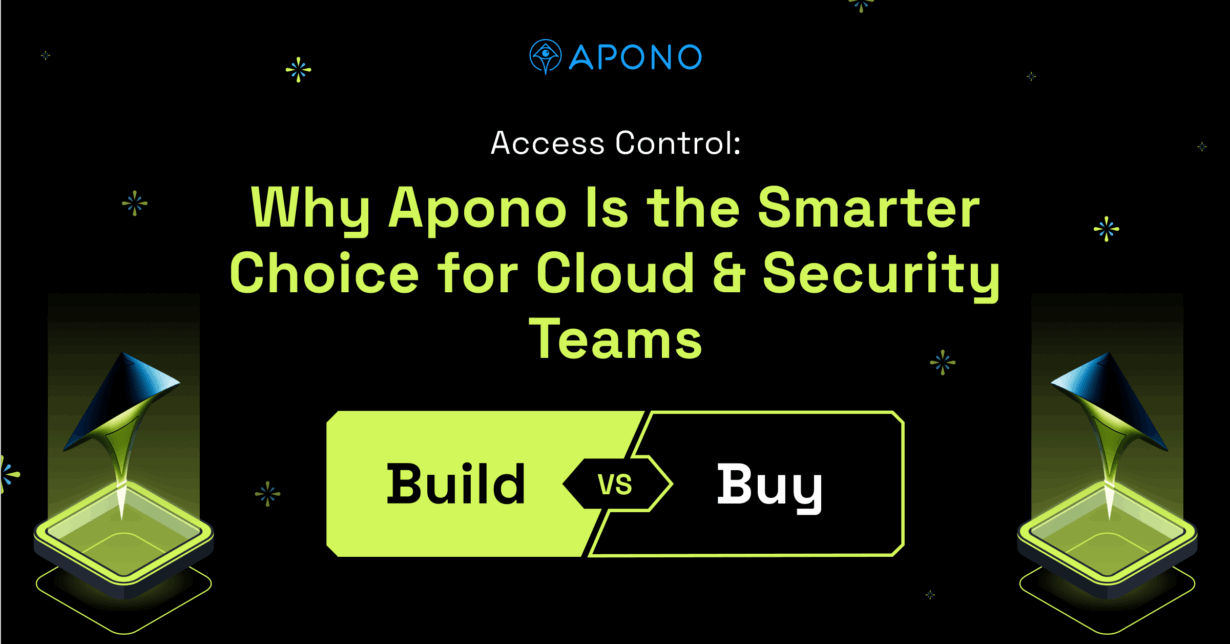Build vs. Buy Access Control: Why Apono Is the Smarter Choice for Cloud & Security Teams

The Apono Team
September 30, 2025

The Access Management Dilemma in Hybrid Environments
Security and engineering teams today face a tough balance: protecting sensitive resources while keeping developers productive. As organizations shift from on-prem to the cloud, access management becomes one of the biggest challenges.
With more identities—human and non-human—gaining access to more resources across hybrid environments, the risks rise. Studies show that over 95% of identities hold excessive privileges, and attackers are exploiting this reality, with 88% of breaches starting from compromised identities.
It’s natural for engineering teams to want to “build” their own Just-in-Time (JIT) access solution. But is that really the best use of resources? Increasingly, organizations are asking themselves:
Should we build an in-house solution or buy a platform that delivers secure, scalable JIT access out-of-the-box?
This article explores the trade-offs of building vs. buying so you can make the right choice for your organization.
The Real Costs of Building Your Own JIT Access Management
Rolling your own JIT solution sounds simple, but in practice, it’s often a patchwork of services, scripts, and ongoing maintenance.
What it takes to build:
- Provisioning logic: Microservices or Lambdas to trigger access grants/revocations.
- Rules engine: Custom service to decide who can request what.
- Integrations: Connectors for each cloud, app, and service.
- Role management: Mining roles, setting up RBAC, auditing usage.
The hidden cost:
- Every API change or new service means potentially new engineering work, requiring design, development and testing.
- DIY systems are usually scoped for niche apps. Not broad coverage leaving huge gaps including how to support the rest of the identity fabric and related tools.
- Continuous upkeep and testing drains developer time and slows agility.
In short, the challenge isn’t just building. It’s maintaining, its testing, its patching and scanning for vulnerabilities. It’s having a team to support you.
💡 Thinking about building your own solution?
See how leading teams evaluate Cloud PAM platforms before they commit. Download the Access Platform Buyer’s Guide here
Build vs Buy Comparison Table
| Factor | Build In-House | Buy a Platform (General) | Apono Advantage |
| Speed to Deploy | Months to design, develop, and test, resulting in a slower time-to-value. | Typically faster deployment with vendor-provided integrations and support. | API-first deployment with Terraform, Helm, CloudFormation; Slack/Teams-native workflows for fast adoption. |
| Role Creation Model | Often depends on pre-created roles — slow to adapt, prone to over/under-privilege. | Many solutions offer role management, which may require predefined roles or templates. | Dynamic roles created in real time, scoped to the task, auto-expire, and adapt automatically to business context. |
| Coverage | Limited to your team’s integration work; gaps likely in multi-cloud/SaaS. | Most vendors offer coverage across major cloud and SaaS platforms, but breadth and depth can vary. | Comprehensive support across AWS, Azure, GCP, Kubernetes, SaaS, and NHIs; single-pane-of-glass management. |
| Operational Overhead | Continuous upkeep for API changes, security patches, and policy logic. | Vendor-managed updates and maintenance help reduce the burden on internal teams. | Fully vendor-managed with continuous support for new APIs; automated discovery reduces admin effort. |
| Customization | Fully tailored to unique workflows and niche systems. | Platforms typically offer policy frameworks and workflow flexibility, though some adjustments may be needed. | Granular Access Flows and contextual policies, easily adapted to customer workflows without brittle custom code. |
| Security Posture | Risk of drift if roles aren’t updated quickly; harder to keep least privilege. | Most platforms provide controls for enforcing least privilege, although they are often tied to predefined structures. | Real-time context evaluation ensures least privilege with just-in-time and just-enough access; supports NHI quarantine. |
| Slack / Jira Integration | Requires custom development and ongoing maintenance. | Many platforms offer some integrations, with varying depths. | Deep Slack, Teams, and Jira integrations for request → approve → provision flows. |
| Auto-Expiring Roles | Must be built and maintained manually with custom scripts. | Some vendors provide time-limited role options. | Native auto-expiring, context-aware roles scoped to the task. |
| Audit Logging | Logs are often fragmented across different systems, requiring manual correlation. | Platforms provide centralized logging, but the depth can vary. | Unified session auditing with identity-to-action tracking, SIEM & ticketing integration. |
| Deployment | Complex build-out requiring internal engineering resources. | Vendor platforms usually offer guided setup and professional services. | Fast, API-based deployment with pre-built integrations and self-service rollout. |
Apono’s Secure by Design Architecture
They say never roll your own crypto—because with great power comes great responsibility. The same applies to JIT access. It holds the keys to your most sensitive crown jewels, so protecting it must be a top priority.
Whether it’s a Lambda function or another microservice handling provisioning, it carries a lot of permissions. The real question: how are you ensuring it can’t be compromised, thereby handing attackers the keys to the kingdom?
Apono’s patented secure architecture keeps your environment fully in your control. Our platform runs on two lightweight components:
- The Web App – where admins create and manage access flows. It never touches your data or resources.
- The Connector – deployed inside your cloud, fully under your control, executing only pre-defined actions and never storing secrets.
Why it matters:
- No data exposure – Apono never reads your files, code, or datasets.
- Secrets stay secret – Credentials are pulled directly from your cloud’s secret store and never cached.
- Always available – High-availability design ensures access flows keep running without downtime.
- Compliance built-in – Password resets and credential rotation are enforced automatically.
With Apono, all access stays in your environment—you get secure, reliable, and compliant access management without friction.
What Engineering Leaders Are Choosing
Monday.com transitioned from maintenance-heavy in-house workflows to a secure, scalable, and developer-friendly platform—powered by Apono
ROI at Scale
- 14,600+ developer hours saved per year through instant, auto-approved access.
- 3,800+ DevOps hours saved per year by eliminating manual access handling.
- 18,000+ hours reclaimed annually while strengthening compliance and reducing risk.
ROI Of Your Internal Resources Is On What You Can Sell
If you’re managing access to a niche or one-off resource, building something in-house might feel tempting. But the reality is that most teams quickly learn the cost is higher than the benefit: ongoing maintenance, constant patching, compliance reviews, and dedicating precious engineering cycles to “plumbing” instead of product.
Modern teams need speed, security, and scalability—not another internal project to babysit. A proven cloud-native JIT access management solution delivers reliability out of the box, reduces risk, and frees your engineers to do what they do best: ship value to customers.
Don’t Build What You Could Buy Smarter.
Download the Buyer’s Guide to learn how leading security teams compare Cloud PAM platforms — and why Apono is built for speed, scale, and Zero Standing Privilege.







